Sanmi Koyejo
Stanford University
End-to-End Test-Time Training for Long Context
Dec 31, 2025Abstract:We formulate long-context language modeling as a problem in continual learning rather than architecture design. Under this formulation, we only use a standard architecture -- a Transformer with sliding-window attention. However, our model continues learning at test time via next-token prediction on the given context, compressing the context it reads into its weights. In addition, we improve the model's initialization for learning at test time via meta-learning at training time. Overall, our method, a form of Test-Time Training (TTT), is End-to-End (E2E) both at test time (via next-token prediction) and training time (via meta-learning), in contrast to previous forms. We conduct extensive experiments with a focus on scaling properties. In particular, for 3B models trained with 164B tokens, our method (TTT-E2E) scales with context length in the same way as Transformer with full attention, while others, such as Mamba 2 and Gated DeltaNet, do not. However, similar to RNNs, TTT-E2E has constant inference latency regardless of context length, making it 2.7 times faster than full attention for 128K context. Our code is publicly available.
CURE: Cultural Understanding and Reasoning Evaluation - A Framework for "Thick" Culture Alignment Evaluation in LLMs
Nov 15, 2025Abstract:Large language models (LLMs) are increasingly deployed in culturally diverse environments, yet existing evaluations of cultural competence remain limited. Existing methods focus on de-contextualized correctness or forced-choice judgments, overlooking the need for cultural understanding and reasoning required for appropriate responses. To address this gap, we introduce a set of benchmarks that, instead of directly probing abstract norms or isolated statements, present models with realistic situational contexts that require culturally grounded reasoning. In addition to the standard Exact Match metric, we introduce four complementary metrics (Coverage, Specificity, Connotation, and Coherence) to capture different dimensions of model's response quality. Empirical analysis across frontier models reveals that thin evaluation systematically overestimates cultural competence and produces unstable assessments with high variance. In contrast, thick evaluation exposes differences in reasoning depth, reduces variance, and provides more stable, interpretable signals of cultural understanding.
Who Evaluates AI's Social Impacts? Mapping Coverage and Gaps in First and Third Party Evaluations
Nov 06, 2025



Abstract:Foundation models are increasingly central to high-stakes AI systems, and governance frameworks now depend on evaluations to assess their risks and capabilities. Although general capability evaluations are widespread, social impact assessments covering bias, fairness, privacy, environmental costs, and labor practices remain uneven across the AI ecosystem. To characterize this landscape, we conduct the first comprehensive analysis of both first-party and third-party social impact evaluation reporting across a wide range of model developers. Our study examines 186 first-party release reports and 183 post-release evaluation sources, and complements this quantitative analysis with interviews of model developers. We find a clear division of evaluation labor: first-party reporting is sparse, often superficial, and has declined over time in key areas such as environmental impact and bias, while third-party evaluators including academic researchers, nonprofits, and independent organizations provide broader and more rigorous coverage of bias, harmful content, and performance disparities. However, this complementarity has limits. Only model developers can authoritatively report on data provenance, content moderation labor, financial costs, and training infrastructure, yet interviews reveal that these disclosures are often deprioritized unless tied to product adoption or regulatory compliance. Our findings indicate that current evaluation practices leave major gaps in assessing AI's societal impacts, highlighting the urgent need for policies that promote developer transparency, strengthen independent evaluation ecosystems, and create shared infrastructure to aggregate and compare third-party evaluations in a consistent and accessible way.
Understanding Adversarial Transfer: Why Representation-Space Attacks Fail Where Data-Space Attacks Succeed
Oct 01, 2025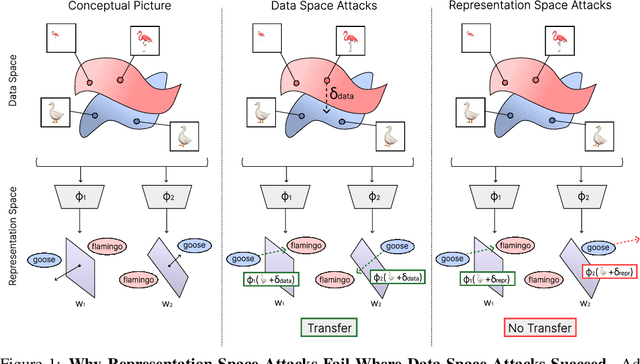
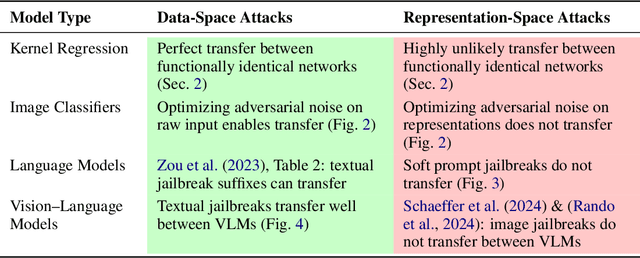


Abstract:The field of adversarial robustness has long established that adversarial examples can successfully transfer between image classifiers and that text jailbreaks can successfully transfer between language models (LMs). However, a pair of recent studies reported being unable to successfully transfer image jailbreaks between vision-language models (VLMs). To explain this striking difference, we propose a fundamental distinction regarding the transferability of attacks against machine learning models: attacks in the input data-space can transfer, whereas attacks in model representation space do not, at least not without geometric alignment of representations. We then provide theoretical and empirical evidence of this hypothesis in four different settings. First, we mathematically prove this distinction in a simple setting where two networks compute the same input-output map but via different representations. Second, we construct representation-space attacks against image classifiers that are as successful as well-known data-space attacks, but fail to transfer. Third, we construct representation-space attacks against LMs that successfully jailbreak the attacked models but again fail to transfer. Fourth, we construct data-space attacks against VLMs that successfully transfer to new VLMs, and we show that representation space attacks \emph{can} transfer when VLMs' latent geometries are sufficiently aligned in post-projector space. Our work reveals that adversarial transfer is not an inherent property of all attacks but contingent on their operational domain - the shared data-space versus models' unique representation spaces - a critical insight for building more robust models.
UQ: Assessing Language Models on Unsolved Questions
Aug 25, 2025Abstract:Benchmarks shape progress in AI research. A useful benchmark should be both difficult and realistic: questions should challenge frontier models while also reflecting real-world usage. Yet, current paradigms face a difficulty-realism tension: exam-style benchmarks are often made artificially difficult with limited real-world value, while benchmarks based on real user interaction often skew toward easy, high-frequency problems. In this work, we explore a radically different paradigm: assessing models on unsolved questions. Rather than a static benchmark scored once, we curate unsolved questions and evaluate models asynchronously over time with validator-assisted screening and community verification. We introduce UQ, a testbed of 500 challenging, diverse questions sourced from Stack Exchange, spanning topics from CS theory and math to sci-fi and history, probing capabilities including reasoning, factuality, and browsing. UQ is difficult and realistic by construction: unsolved questions are often hard and naturally arise when humans seek answers, thus solving them yields direct real-world value. Our contributions are threefold: (1) UQ-Dataset and its collection pipeline combining rule-based filters, LLM judges, and human review to ensure question quality (e.g., well-defined and difficult); (2) UQ-Validators, compound validation strategies that leverage the generator-validator gap to provide evaluation signals and pre-screen candidate solutions for human review; and (3) UQ-Platform, an open platform where experts collectively verify questions and solutions. The top model passes UQ-validation on only 15% of questions, and preliminary human verification has already identified correct answers among those that passed. UQ charts a path for evaluating frontier models on real-world, open-ended challenges, where success pushes the frontier of human knowledge. We release UQ at https://uq.stanford.edu.
Algorithmic Fairness amid Social Determinants: Reflection, Characterization, and Approach
Aug 10, 2025



Abstract:Social determinants are variables that, while not directly pertaining to any specific individual, capture key aspects of contexts and environments that have direct causal influences on certain attributes of an individual. Previous algorithmic fairness literature has primarily focused on sensitive attributes, often overlooking the role of social determinants. Our paper addresses this gap by introducing formal and quantitative rigor into a space that has been shaped largely by qualitative proposals regarding the use of social determinants. To demonstrate theoretical perspectives and practical applicability, we examine a concrete setting of college admissions, using region as a proxy for social determinants. Our approach leverages a region-based analysis with Gamma distribution parameterization to model how social determinants impact individual outcomes. Despite its simplicity, our method quantitatively recovers findings that resonate with nuanced insights in previous qualitative debates, that are often missed by existing algorithmic fairness approaches. Our findings suggest that mitigation strategies centering solely around sensitive attributes may introduce new structural injustice when addressing existing discrimination. Considering both sensitive attributes and social determinants facilitates a more comprehensive explication of benefits and burdens experienced by individuals from diverse demographic backgrounds as well as contextual environments, which is essential for understanding and achieving fairness effectively and transparently.
Let's Measure Information Step-by-Step: LLM-Based Evaluation Beyond Vibes
Aug 07, 2025Abstract:We develop mechanisms for evaluating AI systems without ground truth by exploiting a connection between gaming resistance and output quality. The data processing inequality ensures post-hoc attempts to game a metric degrades both information content and task performance. We prove that f-mutual information measures are the unique gaming resistant mechanisms under natural conditions, with the overseer acting as an agent. While Shannon mutual information faces exponential sample complexity, bounded measures like total variation distance remain tractable. Empirically, across ten domains from translation to peer review, all information-theoretic mechanisms achieve perfect discrimination (d > 0.5) between faithful and strategic agents. In contrast, LLM judges exhibit systematic evaluation inversion, preferring fabricated content over accurate summaries. Our mechanisms show 10-100x better robustness to adversarial manipulation than current practices. We also find performance follows an inverted-U curve with compression ratio, peaking at 10:1 where agent responses exhibit optimal information diversity (3 effective dimensions), giving a bias-variance perspective on when our approach is expected to be most effective.
From Passive to Active Reasoning: Can Large Language Models Ask the Right Questions under Incomplete Information?
Jun 09, 2025



Abstract:While existing benchmarks probe the reasoning abilities of large language models (LLMs) across diverse domains, they predominantly assess passive reasoning, providing models with all the information needed to reach a solution. By contrast, active reasoning-where an LLM must interact with external systems to acquire missing evidence or data-has received little systematic attention. To address this shortfall, we present AR-Bench, a novel benchmark designed explicitly to evaluate an LLM's active reasoning skills. AR-Bench comprises three task families-detective cases, situation puzzles, and guessing numbers-that together simulate real-world, agentic scenarios and measure performance across commonsense, logical, and symbolic reasoning challenges. Empirical evaluation on AR-Bench demonstrates that contemporary LLMs exhibit pronounced difficulties with active reasoning: they frequently fail to acquire or leverage the information needed to solve tasks. This gap highlights a stark divergence between their passive and active reasoning abilities. Moreover, ablation studies indicate that even advanced strategies, such as tree-based searching or post-training approaches, yield only modest gains and fall short of the levels required for real-world deployment. Collectively, these findings highlight the critical need to advance methodology for active reasoning, e.g., incorporating interactive learning, real-time feedback loops, and environment-aware objectives for training. The benchmark is publicly available at: https://github.com/tmlr-group/AR-Bench.
Certified Unlearning for Neural Networks
Jun 08, 2025
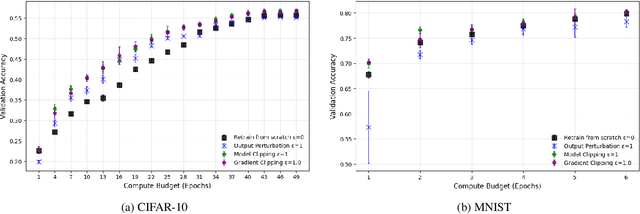
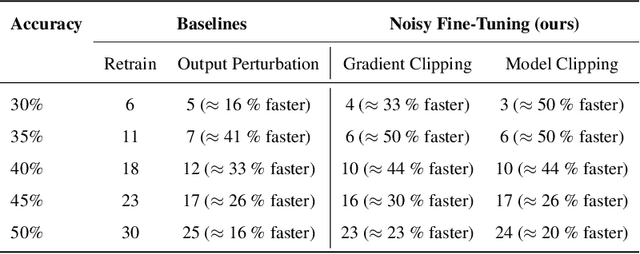
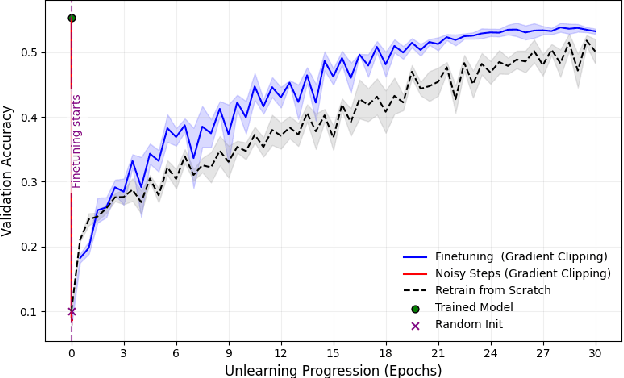
Abstract:We address the problem of machine unlearning, where the goal is to remove the influence of specific training data from a model upon request, motivated by privacy concerns and regulatory requirements such as the "right to be forgotten." Unfortunately, existing methods rely on restrictive assumptions or lack formal guarantees. To this end, we propose a novel method for certified machine unlearning, leveraging the connection between unlearning and privacy amplification by stochastic post-processing. Our method uses noisy fine-tuning on the retain data, i.e., data that does not need to be removed, to ensure provable unlearning guarantees. This approach requires no assumptions about the underlying loss function, making it broadly applicable across diverse settings. We analyze the theoretical trade-offs in efficiency and accuracy and demonstrate empirically that our method not only achieves formal unlearning guarantees but also performs effectively in practice, outperforming existing baselines. Our code is available at https://github.com/stair-lab/certified-unlearningneural-networks-icml-2025
The Optimization Paradox in Clinical AI Multi-Agent Systems
Jun 06, 2025Abstract:Multi-agent artificial intelligence systems are increasingly deployed in clinical settings, yet the relationship between component-level optimization and system-wide performance remains poorly understood. We evaluated this relationship using 2,400 real patient cases from the MIMIC-CDM dataset across four abdominal pathologies (appendicitis, pancreatitis, cholecystitis, diverticulitis), decomposing clinical diagnosis into information gathering, interpretation, and differential diagnosis. We evaluated single agent systems (one model performing all tasks) against multi-agent systems (specialized models for each task) using comprehensive metrics spanning diagnostic outcomes, process adherence, and cost efficiency. Our results reveal a paradox: while multi-agent systems generally outperformed single agents, the component-optimized or Best of Breed system with superior components and excellent process metrics (85.5% information accuracy) significantly underperformed in diagnostic accuracy (67.7% vs. 77.4% for a top multi-agent system). This finding underscores that successful integration of AI in healthcare requires not just component level optimization but also attention to information flow and compatibility between agents. Our findings highlight the need for end to end system validation rather than relying on component metrics alone.
 Add to Chrome
Add to Chrome Add to Firefox
Add to Firefox Add to Edge
Add to Edge